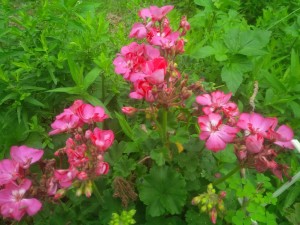
Life is full of rules. Some, like “no wearing white after Labor Day”, arrived via well-meaning mothers and grandmothers. Others are rules that we impose on ourselves. One of the garden rules that has lurked in the back of my mind forever is “geraniums belong in pots”.
The geraniums I deal with most often are the hardy types that can live year-round in the garden. They are wonderful perennials and the range is so large that you can find a hardy geranium for just about any situation. You can also grow hardy geraniums in pots, but most of them time, their feet are firmly planted in beds and borders.
Right now I am thinking of pelargoniums–botanically Pelargonium x hortorum–the traditional fluffy-headed creatures that we have all grown in pots and window boxes forever. They are floriferous, reliable and come in just about every color, excluding true blues.
I was out walking in my suburban neighborhood not long ago and I spotted something much, much more antithetical to the suburban ethos than wearing white after Labor Day. Passing a front flower bed I saw white geraniums planted in a border. There was not a pot in sight and the geraniums were cavorting with all the aplomb of the other perennials in the landscape. Situated at the front of a sunny border, the white globes and lobed green leaves were alternated with plantings of low-growing variegated euonymus.
This combination told me that the gardener was sophisticated. The euonymus is evergreen and interesting in all four seasons. The geranium is tender and cannot survive cold winters, but in the growing season, it flowers often and abundantly. The pure white blooms were a nice contrast with the busy variegated foliage of the shrub. The whole thing looked effortless, cool and inviting, even on a day when the temperature was over ninety and the heat index should have been rated “H” for hellacious.
I thought about the geranium/low evergreen combination. Any of the pink geraniums, either bright or soft pastel, would look equally good interspersed with ‘Blue Rug’ juniper or Juniperus horizontalis wilsonii. ‘Blue Rug’ creeps along the ground, covering territory and blocking weeds. Most of the pink geraniums have just a bit of blue in their color profiles, making them a perfect foil for the blue-gray of the juniper. This combo planting strategy would work especially well with new juniper specimens that have not yet had time to fill much space. Once established, both juniper and geraniums sip, rather than gulp, water which is a plus in dry periods.
You could do the same kind of pairing with lavender, which requires similar free-draining soil, good air circulation and lots of sunshine. The combination would be spectacular no garden varmint in the world that would try and eat it. Catmint, with its equally blue-gray leaves would work as well.
Of course, in warm winter climates, people are much more likely to grow pelargoniums in regular flower beds, because the plants can survive for a year or two—sometimes more—with little attention other than deadheading and occasional haircuts to keep the plants from becoming “leggy” and unattractive. I remember reading an article by Irish novelist and gardener Frank Ronan about growing pelargoniums in his California garden. Unlike the tidy Irish and English geraniums that he was used to, the California specimens sprawled with wild abandon, revealing their true natures. I think he found that behavior very typically American.
All of the above combinations would be easy to care for. Most people treat geraniums as annuals, digging them up and composting the plants after the first hard frost. Thrifty gardeners have long taken stem cuttings from their geraniums in fall, dipping the cut ends in rooting hormone and potting them up, thereby providing a fresh supply in the spring. You can do it either way, depending on time and inclination.
If you fancy the combination of low-growing evergreens and pelargoniums, you can also extend the bloom season by planting tulips when you remove the geraniums in the fall. Pulling out the geraniums loosens the soil, allowing you to plop three to five tulips in each geranium space. The tulips come up in the spring, delighting the eye. When they finish blooming and the leaves start to turn brown, you can lift the bulbs and save or discard. Lifting in this way allows you to plant new or overwintered geraniums in the vacated space.
Like most free-blooming plants, geraniums like regular feeding during the growing season. You can do this with commercial fertilizer, diluted according to package directions. If you overwinter the plants, do not fertilize, as you and they need some down time.
When I think about it, the evergreen/pelargonium combination would also be an interesting way to edge conventional rose beds. When you promote geranium liberation, there is no end to the garden possibilities.
